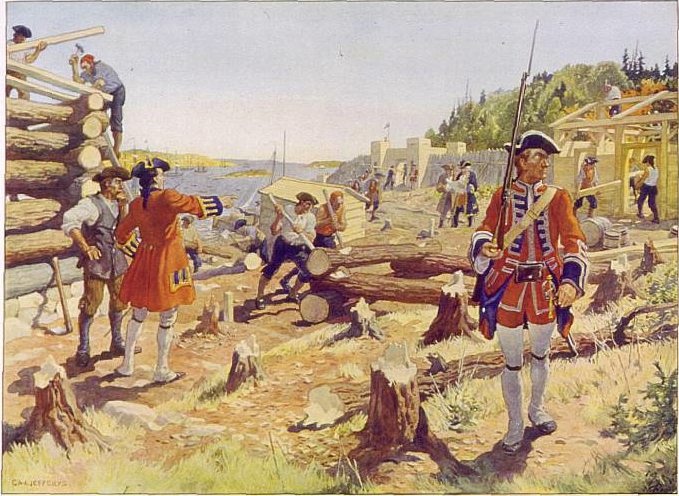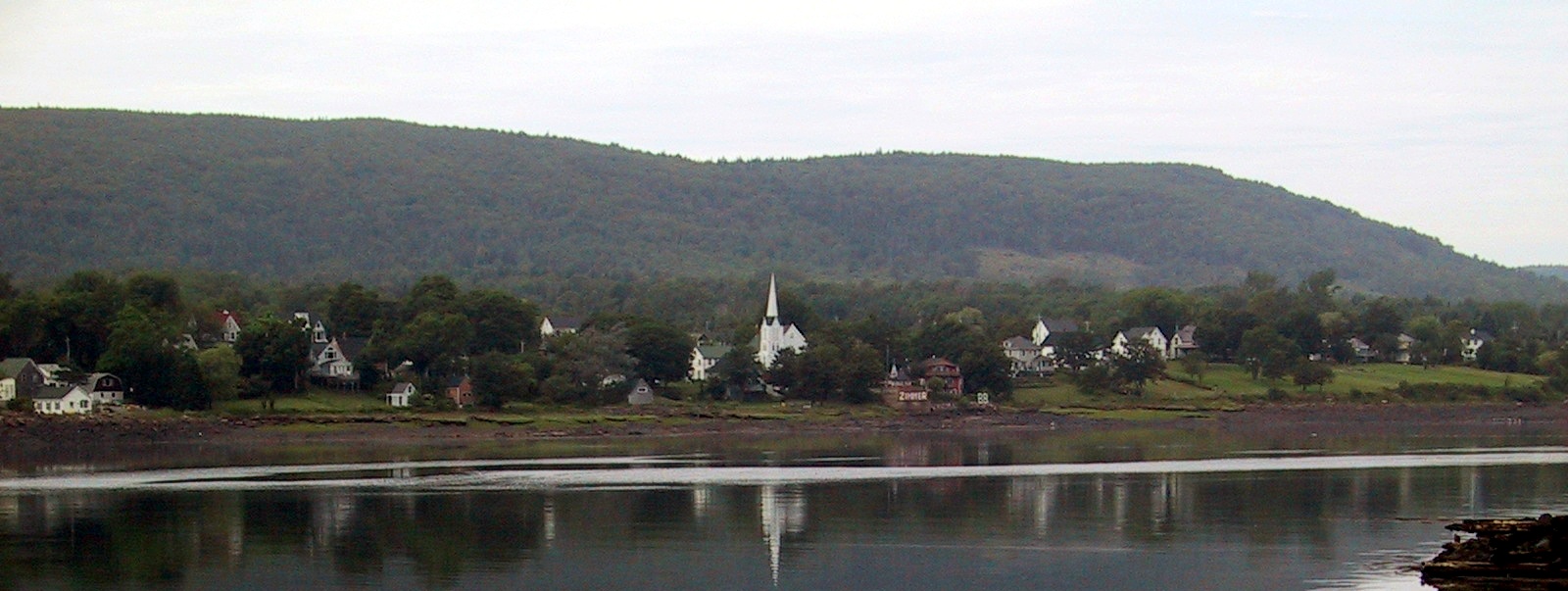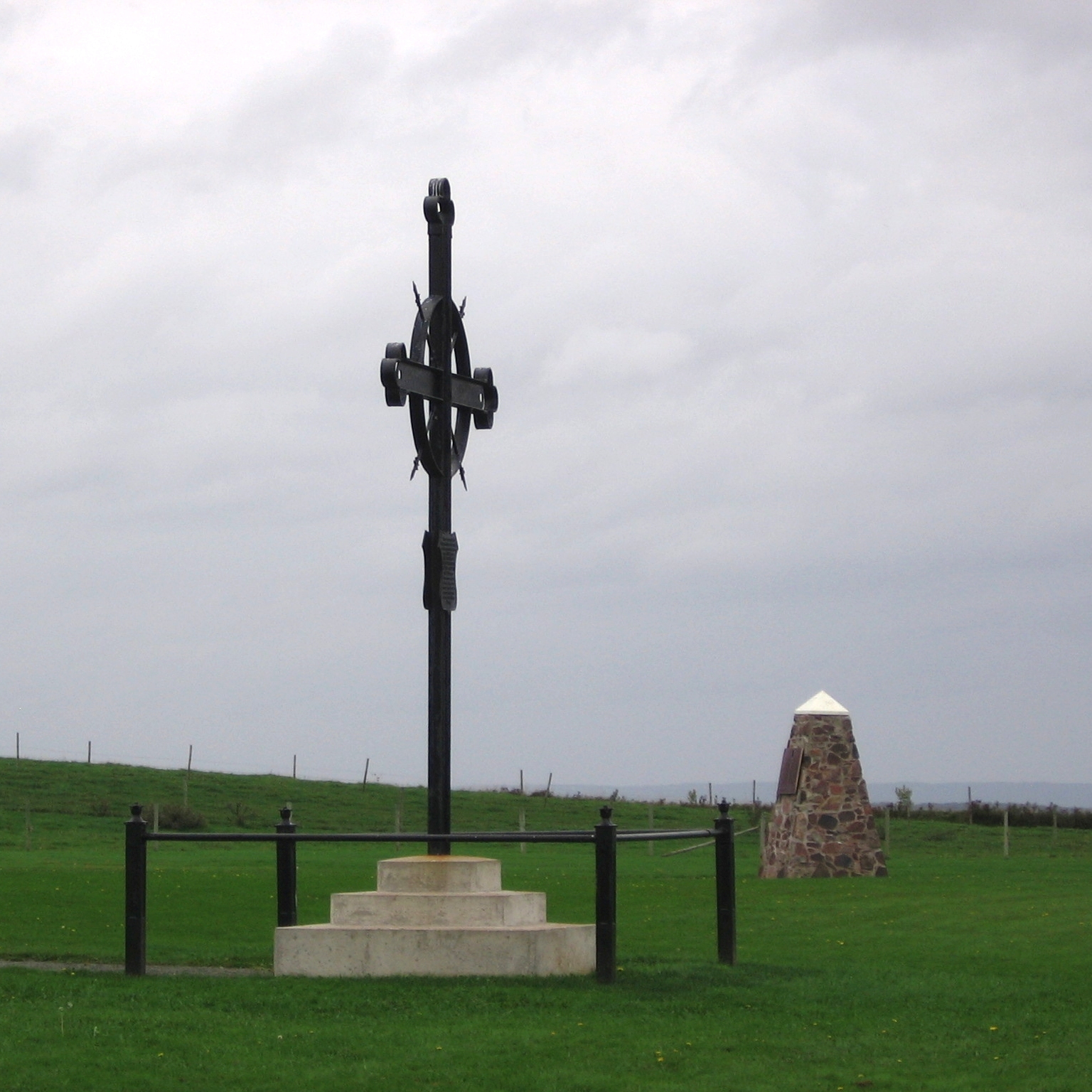|
Fort Hughes (Nova Scotia)
Fort Hughes (also known as the Planters Barracks) was a fortification that was built at present-day Starr's Point, Nova Scotia during the American Revolution to protect against raids by American privateers. The fortification was named after the Governor of Nova Scotia Sir Richard Hughes, 2nd Baronet who had the fortification built on a piece of land belonging to Samuel Starr, a Planter from Norwich, Connecticut and militia officer. Three months after a privateer raid on the Cornwallis river, the Barracks was built in 1778 beside the militia parade ground at Starr's Point. 56 troops were stationed there. The King's Orange Rangers were stationed at the fortification during the Revolution. The Rangers were sent to the area, in part, to ensure that the Planters remained loyal to the King. In the spring of 1781, Major Samuel Bayard led the King's Orange Rangers from Halifax to Fort Hughes to overawe local Planters who were planning to erect a Liberty Pole and thereby break with the Kin ... [...More Info...] [...Related Items...] OR: [Wikipedia] [Google] [Baidu] |
Citadel Hill (Fort George)
Citadel Hill is a hill that is a National Historic Site in Halifax, Nova Scotia, Canada. Four fortifications have been constructed on Citadel Hill since the city was founded by the English in 1749, and were referred to as Fort George—but only the third fort (built between 1794 and 1800) was officially named Fort George. According to General Orders of October 20, 1798, it was named after King George III. The first two and the fourth and current fort, were officially called the Halifax Citadel. The last is a concrete star fort. The Citadel is the fortified summit of Citadel Hill. The hill was first fortified in 1749, the year that Edward Cornwallis oversaw the development of the town of Halifax. Those fortifications were successively rebuilt to defend the town from various enemies. Construction and leveling have lowered the summit by ten to twelve metres. While never attacked, the Citadel was long the keystone to defence of the strategically important Halifax Harbour and its Roy ... [...More Info...] [...Related Items...] OR: [Wikipedia] [Google] [Baidu] |
Military History Of Nova Scotia
Nova Scotia (also known as Mi'kma'ki and Acadia) is a Canadian province located in Canada's Maritimes. The region was initially occupied by Mi'kmaq. The colonial history of Nova Scotia includes the present-day Canadian Maritime provinces and the northern part of Maine ( Sunbury County, Nova Scotia), all of which were at one time part of Nova Scotia. In 1763 Cape Breton Island and St. John's Island (now Prince Edward Island) became part of Nova Scotia. In 1769, St. John's Island became a separate colony. Nova Scotia included present-day New Brunswick until that province was established in 1784. (In 1765, the county of Sunbury was created, and included the territory of present-day New Brunswick and eastern Maine as far as the Penobscot River.) During the first 150 years of European settlement, the colony was primarily made up of Catholic Acadians, Maliseet and Mi'kmaq. During the latter seventy-five years of this time period, there were six colonial wars that took place in Nova Sc ... [...More Info...] [...Related Items...] OR: [Wikipedia] [Google] [Baidu] |
Saint John, New Brunswick
Saint John is a seaport city of the Atlantic Ocean located on the Bay of Fundy in the province of New Brunswick, Canada. Saint John is the oldest incorporated city in Canada, established by royal charter on May 18, 1785, during the reign of King George III. The port is Canada's third-largest port by tonnage with a cargo base that includes dry and liquid bulk, Breakbulk_cargo, break bulk, containers, and cruise. The city was the most populous in New Brunswick until the 2016 census, when it was overtaken by Moncton. It is currently the second-largest city in the province, with a population of 69,895 over an area of . French explorer Samuel de Champlain landed at Saint John Harbour on June 24, 1604 (the feast of St. John the Baptist) and is where the Saint John River (Bay of Fundy), Saint John River gets its name although Mi'kmaq and Maliseet, Wolastoqiyik peoples lived in the region for thousands of years prior calling the river Wolastoq. The Saint John area was an important area ... [...More Info...] [...Related Items...] OR: [Wikipedia] [Google] [Baidu] |
Fort Howe
Fort Howe (1777 — present historic site) was a British fort built in Saint John, New Brunswick during the American Revolution. It was erected shortly after the American siege in 1777 to protect the city from further American raids. The 18th and 19th century British Army fortification stood at the mouth of the Saint John River where it empties into the Bay of Fundy. A replica blockhouse has been constructed approximately 250 metres to the northeast of the original structure. The fort initially held eight cannons, barracks for 100 men, two blockhouses, and an outer wall composed of fascines, sticks and sod. By 1778, the fort consisted of a more substantial blockhouse and barracks located within a palisade, as well as an abatis. A further third blockhouse was constructed at the east end of the hill, which was the continuation of a ridge formed by the St. Croix Highlands - a coastal extension of the Appalachian Mountains along the north shore of the Bay of Fundy. Upon compl ... [...More Info...] [...Related Items...] OR: [Wikipedia] [Google] [Baidu] |
Annapolis Royal
Annapolis Royal, formerly known as Port Royal, is a town located in the western part of Annapolis County, Nova Scotia, Canada. Today's Annapolis Royal is the second French settlement known by the same name and should not be confused with the nearby 1605 French settlement at the Port-Royal National Historic Site also known as the Habitation. In 1629 Scottish settlers established Charles Fort at a new location, but it was ceded to France in 1632 and became the second Port-Royal. This newer French settlement was renamed in honour of Queen Anne following the siege of Port Royal in 1710 by Britain. The town was the capital of Acadia and later Nova Scotia for almost 150 years, until the founding of Halifax in 1749. It was attacked by the British six times before permanently changing hands after the siege of Port Royal in 1710. Over the next fifty years, the French and their allies made six unsuccessful military attempts to regain the capital. Including a raid during the American R ... [...More Info...] [...Related Items...] OR: [Wikipedia] [Google] [Baidu] |
Fort Anne
Fort Anne (first established in 1629 as the Scottish Charles Fort) is a four-bastion fort built to protect the harbour of Annapolis Royal, Nova Scotia. The fort repelled all French attacks during the early stages of King George's War. Now designated a National Historic Site of Canada, it is managed by Parks Canada. Two buildings remain intact: * The 1708 stone powder magazine in Bourgogne Bastion * The 1797 Officer's Quarters was renovated in the 1930s and now house the museum with exhibits about the fort's history and historic artifacts from the area. It was former site of two separate structures: Governor's house and chapel. Other structures were replaced by later work by British: * Bake house in Dauphin Bastion later became underground magazine * Powder magazine in Berry Bastion now vacant Lieutenant Governor house and dry storage building in front of current officers quarters demolished. Currently vacant area. A trail runs along the fort's earthen walls, and provides a ... [...More Info...] [...Related Items...] OR: [Wikipedia] [Google] [Baidu] |
Fort Edward (Nova Scotia)
Fort Edward is a National Historic Site of Canada in Windsor, Nova Scotia, (formerly known as Pisiguit) and was built during Father Le Loutre's War (1749-1755). The British built the fort to help prevent the Acadian Exodus from the region. The Fort is most famous for the role it played both in the Expulsion of the Acadians (1755) and in protecting Halifax, Nova Scotia from a land assault in the American Revolution. While much of Fort Edward has been destroyed, including the officers' quarters (which burned down in 1922) and barracks, the blockhouse that remains is the oldest extant in North America. A cairn was later added to the site. Father Le Loutre's War Despite the British Conquest of Acadia in 1710, Nova Scotia remained primarily occupied by ethnic French Catholic Acadians and Mi'kmaq. Father Le Loutre's War began when Edward Cornwallis arrived with 13 transports on 21 June 1749 to establish Halifax. To guard against Mi'kmaq, Acadian, and French attacks on the new B ... [...More Info...] [...Related Items...] OR: [Wikipedia] [Google] [Baidu] |
Halifax, Nova Scotia
Halifax is the capital and largest municipality of the Canadian province of Nova Scotia, and the largest municipality in Atlantic Canada. As of the 2021 Census, the municipal population was 439,819, with 348,634 people in its urban area. The regional municipality consists of four former municipalities that were amalgamated in 1996: Halifax, Dartmouth, Bedford, and Halifax County. Halifax is a major economic centre in Atlantic Canada, with a large concentration of government services and private sector companies. Major employers and economic generators include the Department of National Defence, Dalhousie University, Nova Scotia Health Authority, Saint Mary's University, the Halifax Shipyard, various levels of government, and the Port of Halifax. Agriculture, fishing, mining, forestry, and natural gas extraction are major resource industries found in the rural areas of the municipality. History Halifax is located within ''Miꞌkmaꞌki'' the traditional ancestral lands ... [...More Info...] [...Related Items...] OR: [Wikipedia] [Google] [Baidu] |
Wilmot, Nova Scotia
Wilmot is an unincorporated community located in Annapolis County in the Canadian province of Nova Scotia. The community takes its name from Wilmot Township, one of the early subdivisions of Annapolis County. The township was named after Montague Wilmot, a colonial governor of Nova Scotia. The township, which included what is now Aylesford, was granted in 1764 to New England Loyalist settlers. In 1768 it had a population of 40; by 1827 it had grown to 2,294. The first major land owner, a magistrate named Philip Richardson, was granted seven lots totaling 2,000 acres (809 ha) in 1777. Brigadier General Timothy Ruggles was granted 10,000 acres (4047 ha) in 1784. Notable People * Samuel Vetch Bayard (1757-1832). Military officer. * Timothy Ruggles (1711-1795). Politician, jurist, military leader. * Joshua Slocum Joshua Slocum (February 20, 1844 – on or shortly after November 14, 1909) was the first person to sail single-handedly around the world. He was a Nova Scotian ... [...More Info...] [...Related Items...] OR: [Wikipedia] [Google] [Baidu] |
New England Planters
The New England Planters were settlers from the New England colonies who responded to invitations by the lieutenant governor (and subsequently governor) of Nova Scotia, Charles Lawrence, to settle lands left vacant by the Bay of Fundy Campaign (1755) of the Acadian Expulsion. History Eight thousand Planters (roughly 2000 families), largely farmers and fishermen, arrived from 1759 to 1768 to take up the offer. The farmers settled mainly on the rich farmland of the Annapolis Valley and in the southern counties of what is now New Brunswick but was then part of Nova Scotia. Most of the fishermen went to the South Shore of Nova Scotia, where they got the same amount of land as the farmers. Many fishermen wanted to move there, especially since they were already fishing off the Nova Scotia coast. The movement of some 2000 families from New England to Nova Scotia in the early 1760s was a small part of the much larger migration of the estimated 66,000 who moved to New York's Mohaw ... [...More Info...] [...Related Items...] OR: [Wikipedia] [Google] [Baidu] |







